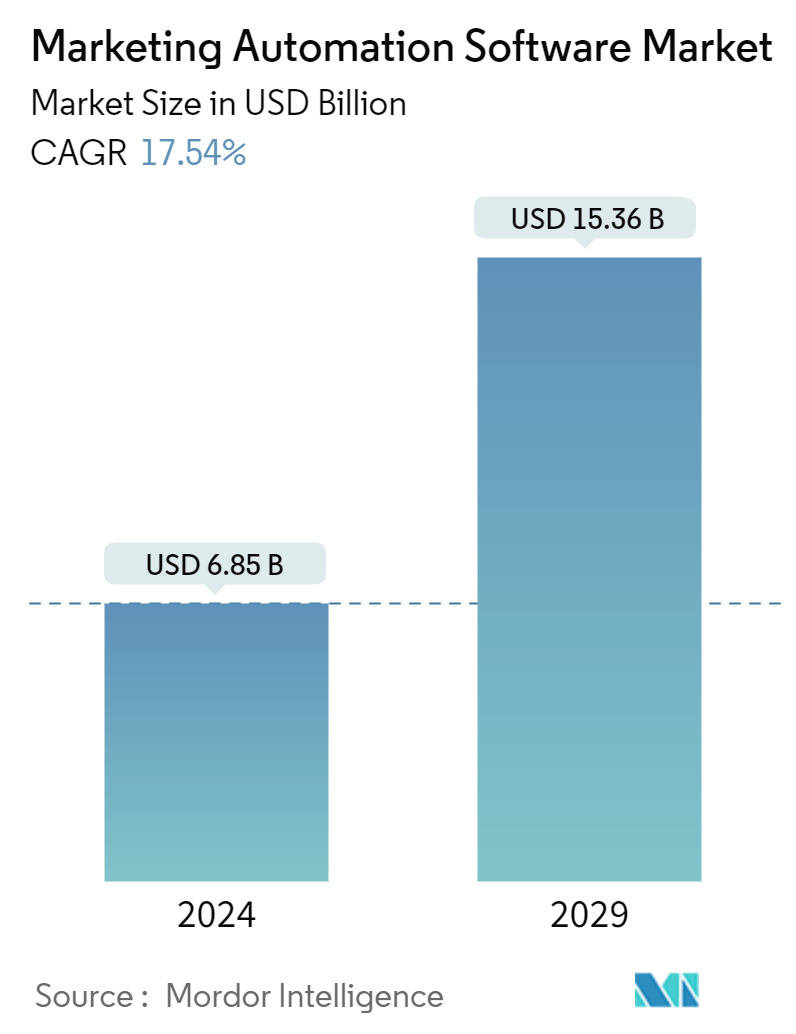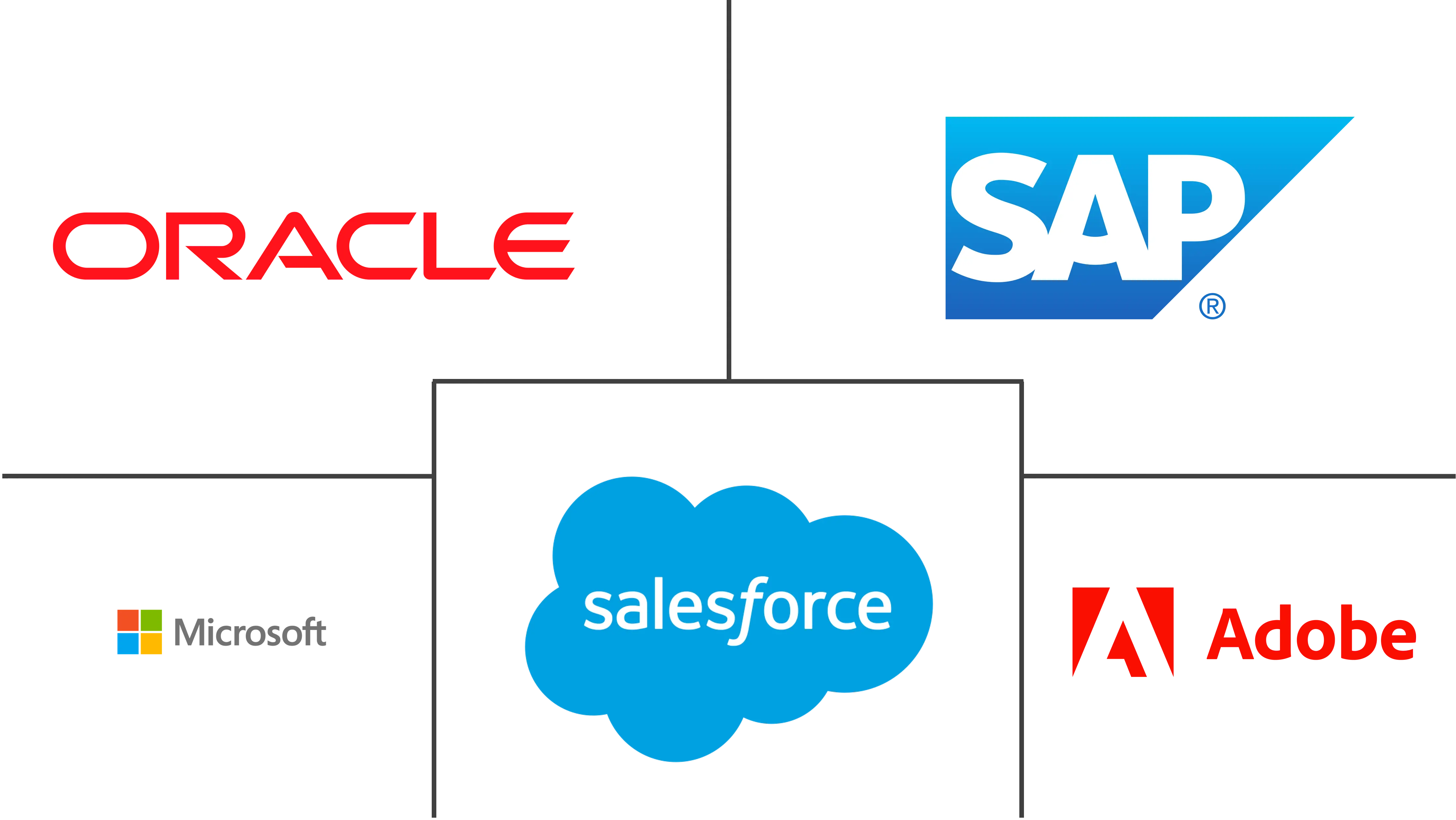Market Size of Industrying Automation Software Market

| Study Period | 2019 - 2029 |
| Market Size (2024) | USD 6.85 Billion |
| Market Size (2029) | USD 15.36 Billion |
| CAGR (2024 - 2029) | 17.54 % |
| Fastest Growing Market | Asia Pacific |
| Largest Market | North America |
Major Players
*Disclaimer: Major Players sorted in no particular order |
Marketing Automation Software Market Analysis
The Marketing Automation Software Market size is estimated at USD 6.85 billion in 2024, and is expected to reach USD 15.36 billion by 2029, growing at a CAGR of 17.54% during the forecast period (2024-2029).
Due to the increasing significance of marketing in generating sales and customer retention, marketing services are witnessing a rise in spending.
- In Order to keep businesses updated with the recent technological disruptions worldwide, marketing managers are strategically spending on marketing automation solutions and tools to adopt the latest digital marketing trends.
- Marketing automation is a technology that aids businesses in creating stronger consumer engagement campaigns by removing tedious activities and allowing the marketing staff to concentrate on more important factors. In addition to other things, the technology makes it easier to manage lead generation and customer lifecycle marketing. As a result, Automated Marketing Tools have drawn a lot of attention in recent years, and it is anticipated that they will continue to rise during the research period.
- From social media marketing to SEO or content marketing, marketing managers are investing significantly to support and boost their sales. Artificial intelligence (AI), data-driven promotion, and search engine optimization (SEO) will give marketing solution providers an advantage in the era of digitization and aggressive promotion techniques. In the upcoming years, AI will present possible opportunities for businesses, sectors, and nations.
- Organic visibility is expected to increase due to the growth in social media marketing campaigns. Various brands improve their return on investment (ROI) by increasing their social media marketing budget. Social media advertisement targeting will likely become highly targeted by mirroring Google's Adwords platform.
- With the introduction of new automation technologies, the market is also experiencing a lack of qualified individuals who can instruct consumers on how to make the most of analytics solutions and use them for helpful information and insights. However, large-sized businesses are concentrating on acquiring smaller ones and providing integrated software suites termed "Marketing Cloud" with the aid of cloud technologies and platforms like IaaS and SaaS. Through mergers and acquisitions, companies can grow their market share and domination by acquiring the necessary knowledge, technology, and client base.
Marketing Automation Software Industry Segmentation
Marketing automation refers to the software that exists with the goal of automating marketing actions. Many marketing departments have to automate repetitive tasks, such as emails, social media, and other website actions.
The Marketing Automation Software Market is segmented by deployment model (cloud-based, on-premise), by size of organization (large-scale, SME-based), by application (campaign management, sales enablement programs, lead management, analytics & reporting solutions), by end user verticals (entertainment and media, financial services, government, healthcare, manufacturing, retail), and by Geography (North America, Europe, Asia Pacific, Latin America, Middle East and Africa). The report offers market forecasts and size in value (USD) for all the above segments.
| By Deployment | |
| Cloud-based | |
| On-Premise |
| By Organization Size | |
| Large-scale | |
| SME-based |
| By Application | |
| Campaign Management | |
| Lead Management | |
| Sales Enablement Programs | |
| Analytics & Reporting Solutions | |
| Other Applications |
| By End-user Vertical | |
| Entertainment & Media | |
| Financial Services | |
| Government | |
| Healthcare | |
| Manufacturing | |
| Retail | |
| Other End-user Verticals |
| By Geography*** | |
| North America | |
| Europe | |
| Asia | |
| Australia and New Zealand | |
| Latin America | |
| Middle East and Africa |
Marketing Automation Software Market Size Summary
The marketing automation software market is experiencing significant growth, driven by the increasing importance of digital marketing in enhancing sales and customer retention. Businesses are investing in automation solutions to stay abreast of technological advancements and to streamline marketing processes, allowing teams to focus on strategic initiatives. This technology facilitates improved consumer engagement through efficient lead generation and customer lifecycle management. The market is witnessing a surge in demand for tools that leverage artificial intelligence, data-driven promotion, and search engine optimization, which are crucial in the current digital landscape. The rise in social media marketing and the need for mobile-optimized solutions further underscore the market's expansion, as brands seek to enhance their return on investment through targeted advertising and personalized marketing strategies.
In North America, the adoption of marketing automation software is rapidly increasing, fueled by a shift towards digital omnichannel marketing and the growing use of SaaS cloud services. The region's market is characterized by intense competition among major vendors, which drives innovation and the development of advanced features. The integration of analytics and personalization services is becoming essential for marketers, offering substantial returns on investment. The market's fragmentation necessitates continuous innovation, as companies strive to offer the latest solutions to meet consumer demands. Recent acquisitions and strategic partnerships among key players highlight the dynamic nature of the market, as firms seek to enhance their capabilities and expand their market presence through technological advancements and integrated software offerings.
Marketing Automation Software Market Size - Table of Contents
-
1. MARKET DYNAMICS
-
1.1 Market Overview
-
1.2 Market Drivers
-
1.2.1 Ongoing Shift Toward Digital-based Campaigns
-
1.2.2 Organizations Realizing the Benefits of Data-backed Decision Process
-
1.2.3 Sustained Increase in Adoption of SMAC-based Technologies
-
-
1.3 Market Challenges
-
1.3.1 Legacy-related Implementation Challenges
-
-
1.4 Market Opportunities
-
1.5 Industry Ecosystem Analysis
-
1.6 Impact of COVID-19 on the Marketing Automation Software Market
-
1.6.1 Short-term Impact
-
1.6.1.1 Changes in B2B marketing budgets and their overall impact on martech budget allocations
-
-
1.6.2 Long-term Impact
-
1.6.2.1 Migration to Digital Mediums and Need for Personalized Campaigns to Gather Traction
-
1.6.2.2 Growth in Collation Of Data Has Increased the Need for Contextualization
-
1.6.2.3 Large-scale Organizations Which Account for a Sizeable Share Remain Relatively Unaffected
-
1.6.2.4 Vendors such as HubSpot Have Successfully Created a Supporting Ecosystem Which Has Helped Them Onboard SMEs
-
-
-
1.7 Impact of Higher Adoption of Digital Transformation Practices and Ongoing Move towards an Integrated CRM Space
-
1.8 Industry Attractiveness - Porter's Five Forces Analysis
-
1.8.1 Threat of New Entrants
-
1.8.2 Bargaining Power of Buyers
-
1.8.3 Bargaining Power of Suppliers
-
1.8.4 Threat of Substitute Products
-
1.8.5 Intensity of Competitive Rivalry
-
-
-
2. MARKET SEGMENTATION
-
2.1 By Deployment
-
2.1.1 Cloud-based
-
2.1.2 On-Premise
-
-
2.2 By Organization Size
-
2.2.1 Large-scale
-
2.2.2 SME-based
-
-
2.3 By Application
-
2.3.1 Campaign Management
-
2.3.2 Lead Management
-
2.3.3 Sales Enablement Programs
-
2.3.4 Analytics & Reporting Solutions
-
2.3.5 Other Applications
-
-
2.4 By End-user Vertical
-
2.4.1 Entertainment & Media
-
2.4.2 Financial Services
-
2.4.3 Government
-
2.4.4 Healthcare
-
2.4.5 Manufacturing
-
2.4.6 Retail
-
2.4.7 Other End-user Verticals
-
-
2.5 By Geography***
-
2.5.1 North America
-
2.5.2 Europe
-
2.5.3 Asia
-
2.5.4 Australia and New Zealand
-
2.5.5 Latin America
-
2.5.6 Middle East and Africa
-
-
Marketing Automation Software Market Size FAQs
How big is the Marketing Automation Software Market?
The Marketing Automation Software Market size is expected to reach USD 6.85 billion in 2024 and grow at a CAGR of 17.54% to reach USD 15.36 billion by 2029.
What is the current Marketing Automation Software Market size?
In 2024, the Marketing Automation Software Market size is expected to reach USD 6.85 billion.

